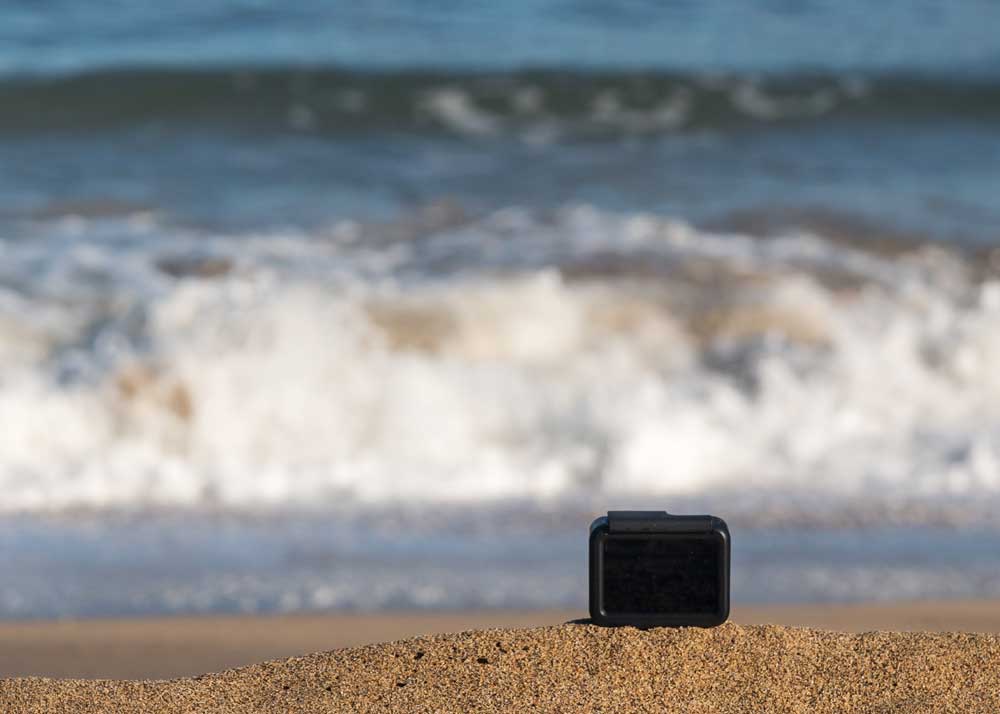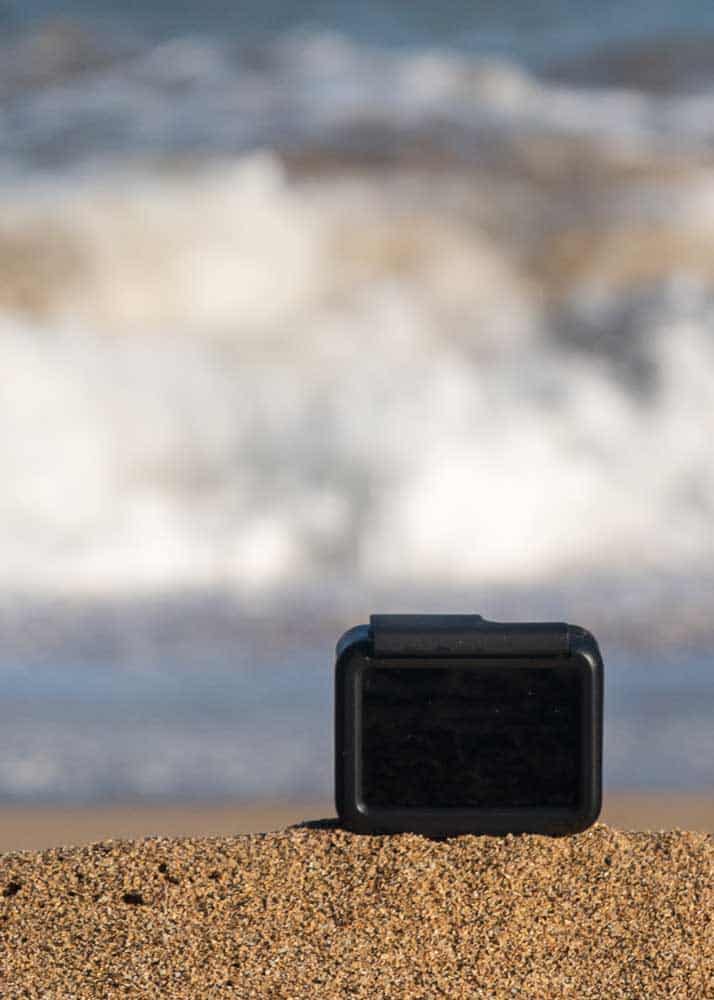If your GoPro has water damage, this post will help. Here’s how to successfully dry your GoPro after getting it wet. Plus, you’ll learn what you should do as soon as your camera gets wet and the factors affecting if it can be saved.

Sure, GoPro cameras are waterproof – but not on the inside. Water needs to stay on the outside of the camera.
Water doesn’t play nice with electronics. If your GoPro gets wet, there is a reasonable chance that you’ll need to buy a new one. But you might be able to save it.
In this post, you’ll learn how to fix water damage to your wet GoPro.
Wet Camera? Here’s What to Do Right Now
Before you decide if and how to repair your wet camera, there are a few things you should do right now.
- Remove Camera from Housing, Mods, and Mounts: To begin the drying process, remove all external mounts and housings.
- Remove Battery: The most important thing to do is remove power from the camera. Electricity and water aren’t friends, and the last thing you’ll want is power going to your components while they’re wet.
- Remove Memory Card: If there is any chance of saving your footage, take your card out right now. Wipe this down with a tissue or napkin and then store it inside a folded paper towel (or equivalent) to allow any remaining moisture to come out.
- Don’t Use a USB cable: Connecting your GoPro to a TV or computer via USB will power it up – and likely make the damage irreparable. You won’t want to do this.
Can My Water-Damaged GoPro Be Repaired?
Can a wet GoPro be fixed? Maybe. It depends on a few factors.
- What type of water leaked? If you were in the ocean or pool, it will be harder to salvage your wet GoPro. Both salt and chlorine are strong oxidizing agents and will quickly destroy the internal components of your camera. Fresh water (lakes and rivers) will be easier on the electronics, and you’ll have a better chance of saving it.
- How long has it been wet? The length of time your camera has been wet matters because oxidization gets worse over time. If you can dry your GoPro the same day as it gets wet, you increase your odds of success.
- How much water entered your GoPro? Was your GoPro completely saturated? Or did just a few drops enter a port? Less moisture entering the camera means it will do less damage and make it easier to dry and repair.
- What is your technical ability? Some of these repairs require a certain level of comfort with a screwdriver and electrical components. And along the same line, how much is your time worth? Realistically, there is a reasonable chance that your wet camera will never shoot again. Is a complex breakdown a good investment of your time? Maybe, but it’s worth considering.
After all these factors, there seems to be a level of randomness as well. Some users have been unable to recover their cameras after even just a little water – while others have repaired their cameras after being fully saturated.
How to Successfully Dry Your GoPro: 6 Tips
Here are some tips to begin drying your GoPro.
Please note: Each of the tips requires caution and has the potential to permanently damage your camera. Please don’t proceed if you aren’t comfortable with the possible effects of your actions.
I can’t be responsible for any failed repairs or losses you incur. These tips are provided as suggestions to consider, and they may not successfully work on your model.
- Remove mount, battery, and SD card: This will help open up the cavities in the camera and allow airflow.
- Rinse with fresh water: Proceed with Caution! While this might not make sense at first, you might need to rinse the camera before beginning the drying process. If it was in salt, chlorine, or muddy water, you’ll want to get the residue out of the camera before removing the water. Otherwise, it might remain and corrode the components.
- Shake the water out: You might swing it allowing centripetal force to move the water out of the camera. Alternatively, you could use compressed air or a vacuum cleaner to remove any drops. Don’t hold the vacuum too close as it can generate static electricity and damage your camera.
- Put it in rice: This is a commonly stated tip for salvaging wet electronics, but I’m not sure how well it works. Results online appear to be mixed. I think this might be my last step – after doing everything else I can do to remove the moisture. And don’t do this before removing any residue (salt, dirt, or chlorine) with a freshwater rinse. Alternatively, you could use silica gel – the tiny packets that come in new electronics packaging. Popular wisdom says that it could take up to one week to fully dry with either rice or silica gel. Results may vary.
- Open the camera: Proceed with Caution! Some users do this to allow the camera to dry and to remove salt, rust, or other residues. Please note that you will void your warranty if you open the case. Plus, if you’re like me, it can be hard to put all the pieces back where they belong. I always end up with a few extra parts after it’s back together. Not recommended.
- Place near a dehumidifier: A couple of days ago, I spilled a full water bottle across my laptop keyboard. After pouring the water out of the housing, I placed it in front of a dehumidifier exhaust in our basement. For the past 36 hours, it has been bathed in a constant flow of dry, warm air. I’m going to try to turn it on later today, and I’m reasonably optimistic.
Update (July 17, 2020): Yesterday, I plugged my soaked laptop back in after placing it in front of a dehumidifier for 1.5 days -and it worked great. Once you clean the debris and salt from your wet camera – I recommend doing the final dry with a dehumidifier or placing it in front of an air conditioner for a day (more time if you can).
What about drying your wet GoPro in a hot car? Some posts suggest placing your camera on your car’s dashboard on a hot day. Don’t do this. A car’s dashboard can reach temperatures of 180 to 200°F (82 to 93°C) after one hour in the hot sun. This could permanently damage your camera. The same goes for drying in an oven – if you’re camera wasn’t ruined by the water, it would be by the heat.
Will GoPro Replace a Water Damaged Camera?
Maybe. They offer two levels of warranty.
- First, they have a 30-day, “no questions asked” warranty. This allows you to return it for a refund if you aren’t “100% satisfied”. Damaged items are not accepted as returns – so this might not work for waterlogged GoPro cameras.
- Second, they offer a 1-year manufacturer defects warranty from the date of purchase. They don’t accept damage by user error. So to get them to make good on the warranty, it must be a defect in the camera – and not because you forgot to close the side port.
Some users (like Katherine at Tara Lets Anywhere and Bench at Sole Wanderer) have successfully had their wet camera replaced by GoPro.
So while it might be a long shot, I think it’s worth a try. Contact GoPro and see what they can do for you – especially if you purchased the camera in the last 12 months.
To avoid “user error” here are 6 tips to keep your GoPro waterproof.
Using Isopropyl Alcohol and Dissembling the GoPro
In this video by Takeapart, you’ll see how he dissembles his Hero5 Black, removes rust near the charging port with isopropyl alcohol, and then successfully puts it back together.
This is beyond my skill level – but I admire what he does in this video.
And there you have it.
This is what to do as soon as your camera gets wet, factors affecting if it can be saved, and how to dry your wet GoPro successfully.
If you’re going to have your GoPro around water, it’s a good idea to attach a GoPro floating handle – so it won’t sink to the bottom of the lake when dropped.

Did you lose your GoPro? Here’s how to find your lost GoPro.
Your Turn
How wet did your camera get? Did you identify the reason for the failure? And most importantly, how did your repair go – did you save your camera? I would love to hear from you below!
- About the Author
- Latest Posts
Hey, I’m Bryan! I’m a content creator and co-founder of Storyteller Tech.
Experienced GoPro Videographer: I’ve been shooting with GoPro cameras for over 11 years. My first GoPro was the Hero3 Silver, bought for a Galapagos work trip in 2012. Today I own 20+ action cameras, including GoPro, DJI, and Insta360 cameras.
Professional Creator: Dena and I have developed video and content marketing plans for numerous international travel brands. And we also run several content businesses.
Bryan also creates at Storyteller.Travel and is co-founder of Storyteller Media, a Canadian-based publishing company.

Edward TURON
Thursday 22nd of April 2021
rice?
Bryan Haines
Friday 23rd of April 2021
Yes, while rice is a commonly shared method, there are some who argue (and tested) that it doesn't actually work that well. I've had good success putting wet electronics in front of a large dehumidifier, with the dry air blowing directly onto the unit.